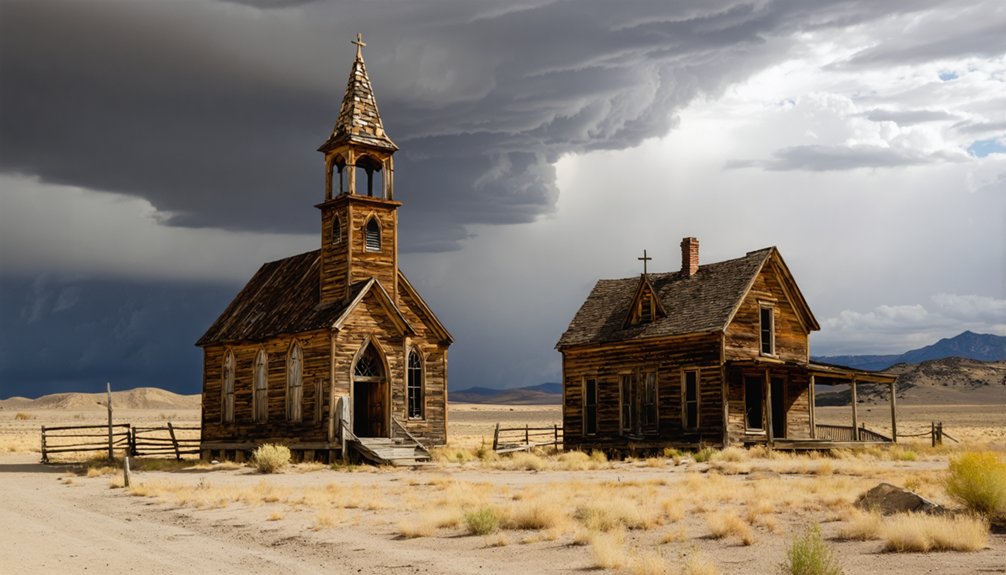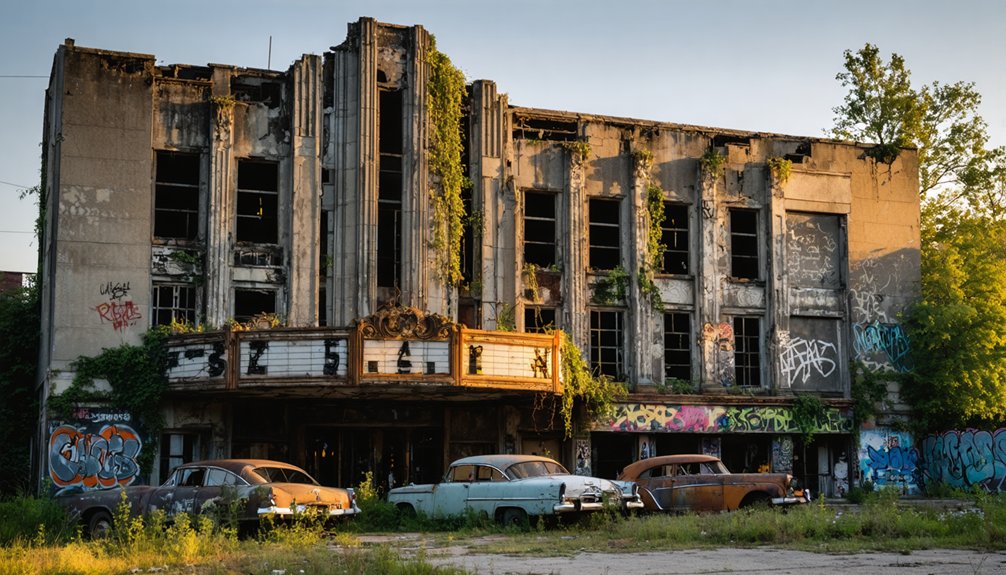You’ll discover haunting remnants of American history in Bodie, California, where over 110 gold rush buildings remain preserved in “arrested decay” since 1876. In Pennsylvania, Centralia’s streets have cracked open from an underground mine fire burning continuously since 1962, inspiring the Silent Hill horror franchise. Alabama’s first capital, Cahaba, now exists only as crumbling foundations reclaimed by floodwaters and abandonment. These ghostly settlements reveal forgotten chapters of ambition, disaster, and inevitable decline.
Key Takeaways
- Bodie, California preserves over 110 original gold rush buildings in a state of “arrested decay” in the Sierra Nevada mountains.
- Centralia, Pennsylvania features a continuously burning underground mine fire since 1962, creating a dangerous, apocalyptic landscape.
- Cahaba, Alabama contains the flooded ruins of the state’s first capital, abandoned due to recurring floods by the early 1900s.
- Each ghost town represents distinct American tragedies: gold rush abandonment, environmental disaster, and nature’s reclamation of civilization.
- Visitors can explore Bodie’s authentic frontier buildings, Centralia’s fractured steaming streets, and Cahaba’s crumbling antebellum foundations.
Bodie, California: Where Time Stands Frozen in the Sierra Nevada
Four prospectors struck gold in 1859 in the Sierra Nevada foothills, establishing what would become one of America’s most infamous boomtowns.
Despite namesake W.S. Bodey perishing in a blizzard shortly after discovery, Bodie‘s misspelled legacy endured.
Though its founder never saw its glory days, the town that couldn’t spell his name properly outlived him by decades.
When miners exposed a rich vein in 1876, the settlement exploded to 10,000 residents with nearly 2,000 structures.
You’ll find Bodie architecture remarkably preserved—from saloons to the advanced 1893 hydro-electric plant—all maintained in “arrested decay.”
Gold mining yielded $38 million during peak years, but as resources depleted, residents abandoned their belongings, creating today’s time capsule effect.
Now California’s official gold rush ghost town, Bodie offers you an authentic glimpse into frontier life, with over 110 original buildings still standing.
The town was infamous for its Wild Western atmosphere, with a staggering 60 saloons operating during its peak in 1880.
A mysterious curse legend surrounds the town, warning visitors against removing artifacts, which has ironically helped preserve Bodie’s historical integrity.
Centralia, Pennsylvania: The Town That Burns From Below
While many ghost towns fell victim to economic decline, Centralia, Pennsylvania faces a more sinister threat—an underground mine fire that has burned continuously since 1962.
What began as a simple trash fire in an abandoned strip mine became an unstoppable inferno when flames penetrated the coal seams beneath the town.
You’ll find eerie remnants of abandoned infrastructure throughout Centralia, where the population plummeted from 1,300 to just five residents by 2020.
Toxic gases, ground temperatures reaching 900°F, and sudden sinkholes make exploration dangerous.
The Centralia fire has transformed ordinary streets into fractured asphalt vents releasing ghostly steam.
This apocalyptic landscape inspired the horror franchise Silent Hill and draws curious visitors despite official warnings.
As you observe the smoke billowing from below, you’re witnessing a disaster that turned an ordinary mining town into America’s most notorious ghost town.
Before the devastating fire, Centralia was once a thriving coal mining community with a peak population of 2,761 in 1890.
The infamous “Graffiti Highway,” an abandoned section of Route 61, became a colorful tourist attraction despite the deadly dangers lurking beneath its buckled surface.
Cahaba, Alabama: Flooded Ruins of a Forgotten Capital
Beneath the gentle waters where the Alabama and Cahaba rivers converge lies Cahaba, Alabama’s first state capital and one of the nation’s most haunting archaeological treasures.
Where rivers meet, Cahaba sleeps—Alabama’s forgotten capital waits beneath the waters, a submerged testament to ambition.
This forgotten riverside settlement reveals a tumultuous Cahaba history—from its 1820 founding as a promising political center to its complete abandonment by the early 1900s.
You’ll find only crumbling foundations and weathered columns where thousands once lived and governed. The flooding impact proved catastrophic; the town’s low position between two rivers brought repeated inundations, disease outbreaks, and eventual exodus. The devastating flood of 1825 caused the statehouse to collapse, prompting the legislature to relocate the capital to Tuscaloosa.
During the Civil War, Castle Morgan prison held thousands of Union soldiers in deplorable conditions, adding to the town’s troubled legacy. Visitors often report seeing blue lantern sightings near the prison ruins, contributing to the town’s ghostly reputation.
Today, the Old Cahawba Archaeological Park preserves these remnants where nature has reclaimed what was once Alabama’s ambitious capital.
Frequently Asked Questions
Why Is Centralia’s “Graffiti Highway” Now Buried?
You’ll find Centralia’s Graffiti Highway buried because property owners faced liability concerns from increasing vandalism. This artistic artifact’s significance within Centralia’s history couldn’t outweigh safety issues beneath the burning coal seams.
Can Visitors Legally Take Artifacts From Bodie?
No, you can’t take artifacts from Bodie. Your freedom ends where artifact preservation begins. Removing items violates California law, resulting in serious legal ramifications and undermining the site’s historical integrity.
What Happens to Those Who Ignore the “Bodie Curse”?
According to Bodie legends, you’ll suffer misfortunes like accidents, illness, or financial ruin if you ignore ghostly warnings and take artifacts. Many visitors return stolen items, believing they’ve experienced the curse’s consequences.
Did Cahaba’s Flooding Problems Contribute to Its Haunted Reputation?
Absolutely. After 80% of Cahaba vanished underwater in major floods, you’ll find these catastrophes shaped Cahaba legends fundamentally. The abandoned, waterlogged ruins became perfect backdrops for spectral stories that persist in flooding history today.
How Do Officials Monitor Ongoing Safety Hazards in These Locations?
Officials conduct regular safety inspections and hazard assessments, monitoring structural stability, contamination levels, and public health risks. You’ll notice warning signs and barriers where they’ve identified dangers requiring your caution.
References
- https://nightofthejack.com/2025/01/23/top-creepy-ghost-towns-in-america/
- https://en.wikipedia.org/wiki/Wikipedia:WikiProject_Ghost_towns
- https://www.christywanders.com/2024/08/top-ghost-towns-for-history-buffs.html
- https://www.tastingtable.com/694562/scariest-ghost-towns-country/
- https://www.visittheusa.com/experience/5-us-ghost-towns-you-must-see
- https://en.wikipedia.org/wiki/Ghost_town
- https://devblog.batchgeo.com/ghost-towns/
- https://www.slideshare.net/slideshow/famous-ghost-towns/26047073
- https://www.geotab.com/ghost-towns/
- https://www.wikiwand.com/en/articles/ghost_town



